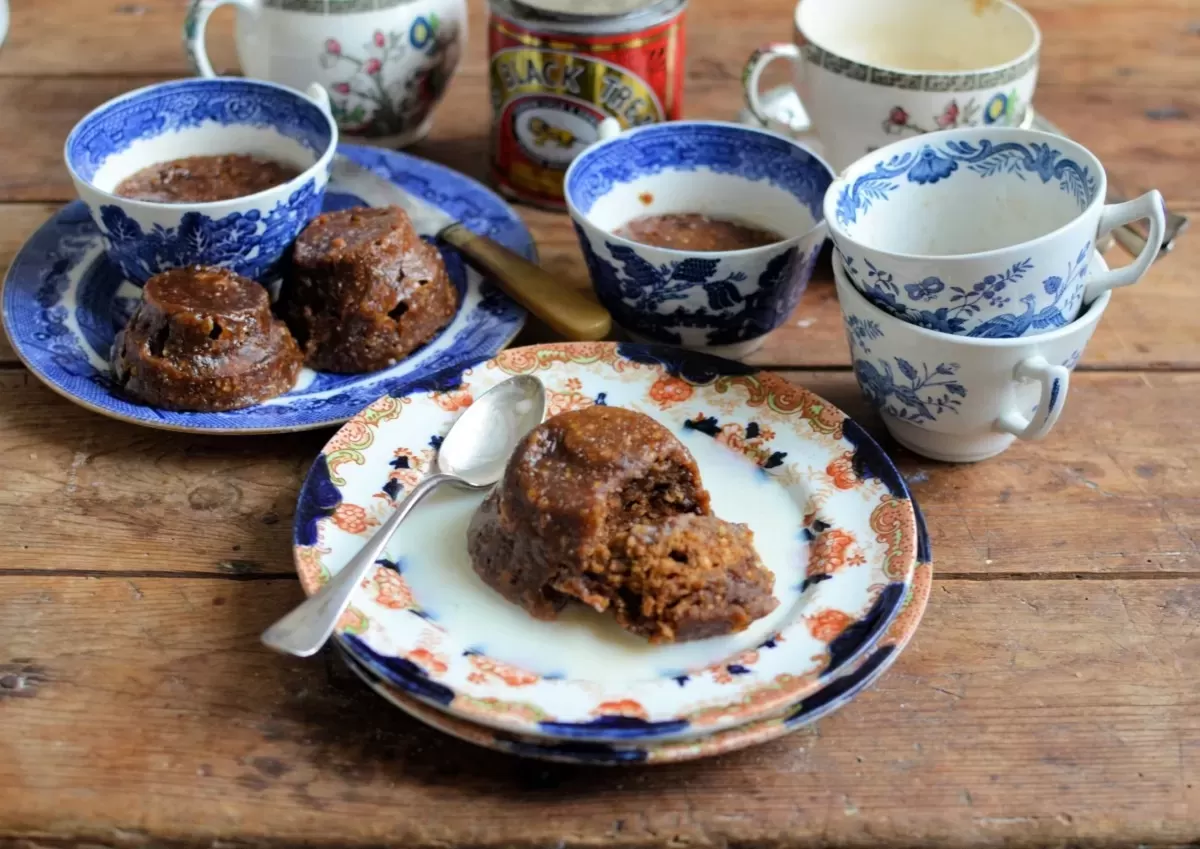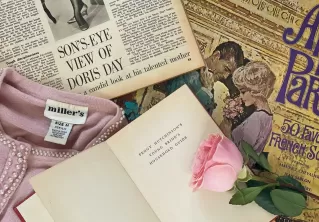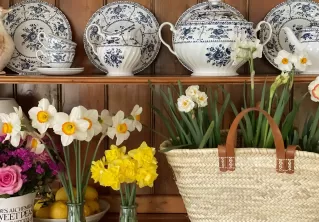Cooking Vintage Recipes: with Lavender and Lovage
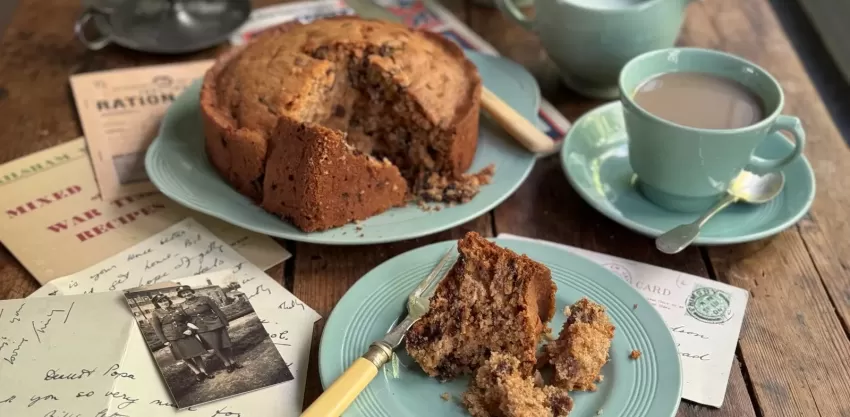
One of my favourite ways to unwind is to immerse myself in a vintage book or magazine, better still if it has recipes or details on the daily life of a homemaker or housewife of yesteryear. I’m absolutely fascinated with domestic history, and the favourite part of any historic house, or “scene” in a period movie or television drama is always in the kitchen.
Searching for a vintage recipe is how I found today’s blog guest a few moons ago now. I think it may have been in early lockdown that a revival of “school puddings” and all things nostalgic really took off. In such an uncertain time, we wanted to feel safe and secure, truly taken care of, as if sitting at the family table with the constant love and reassurance of our parents (whether that was a scenario personally experienced, or hoped for and imagined). An Enid Blyton, or Larkin world perhaps, full of abundance, charm, whimsy, and comfort.
 I remember that the exact recipe that led me to Karen and her blog was a Jam & Coconut Sponge with Pink Custard.
I remember that the exact recipe that led me to Karen and her blog was a Jam & Coconut Sponge with Pink Custard.
Sat amongst the other children in the school canteen of Victoria Road Junior School, greedily tucking into warm sponge and pretty pink custard, and all would ask for seconds of this yummy treat.
Our school Dinner Ladies would make this sponge, and Chocolate Concrete with chocolate custard for pudding regularly, and it was always such a hit with children. I know many generations of British school kids claim it as ‘their own’. It truly takes us back!
I love him dearly, but Jamie Oliver has ruined school dinners for the younger generations in Britain (though, I know his heart is in the right place). But at least we can still make our own! Recipes that remind us of happier, or simpler times are often the most treasured. Those handed down by gran, or mum, maybe an aunt (or neighbour who felt like an aunt), or just a kindly dinner lady are the best ones.
Karen and I have bonded (albeit online), over the years through our love of nostalgia, weird retro and lovely old fashioned recipes, and the history behind these culinary delights. Not to mention the Royal Family (Jam Penny sandwiches were a favourite of HM Queen Elizabeth II, you know), and more than our fair share of hunting for vintage kitchen treasures!
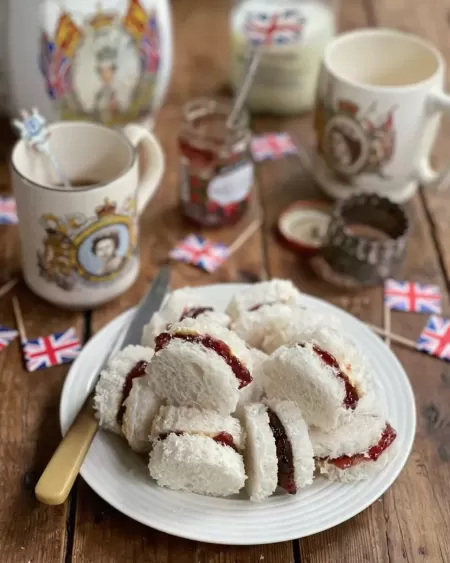
Sometimes nostalgia is truly what we’re craving, and I wanted to share Karen’s blog with you today as one of my favourite resources for planning a menu when “modern” dinner ideas just aren’t cutting it. It’s nice to get to know the woman behind all those recipes too.
So we sat down with a cup of tea, despite there being over 10,000+ miles between us now, and chatted all things vintage recipes, homemaking in Britain and abroad, and what inspires her the most…
![]()
Vintage Recipes with Karen from Lavender & Lovage
 Karen with her daughter Hannah
Karen with her daughter Hannah
Welcome to The Darling Academy Karen! I’d love to know what inspired you to start blogging, and why specifically traditional and vintage recipes?
I used to write for a lovely British magazine, called “Country Kitchen”. It was a magazine dedicated to traditional and historical British recipes, ingredients, feasts, saints days and festivals. I was their recipe and food historian writer, and I had my own byline every month. Sadly, it folded in 2011, such a shame as it was a unique magazine and very popular - so I was effectively out of a job, albeit a part time one!
Close friends told me I should start a blog and write about similar country recipes, mainly vintage, historical and British. So, that’s exactly what I did - starting off on the blogger platform, before moving to Wordpress as my traffic grew. Although I added travel stories and French recipes (I was living in SW France at the time) to the mix, it was predominantly British vintage and what I call heirloom recipes. It’s still my core content now, and an area of culinary history that I absolutely love.
Have you had any kitchen disasters, or can you think of anything disgusting you have cooked and thought, “well this recipe definitely belongs in the past”?
I’ve had many over the years, who hasn’t! However, my most recent recipe disaster was when I was asked to replicate some WWI recipes for “The People’s Friend” magazine, which was for a wartime souvenir issue they were publishing. They sent me a wonderful archive of recipes from 1914 to 1918, and I was asked to make 5 or 6 of them. I chose 3 savoury recipes, and 3 sweet recipes, comprising “Ration Scones”, “Gingerbread Cup Puddings”, and “Jam Tart”.
The scones and jam tart were delectable and truly enjoyable; however, the gingerbread cup puddings were vile! Heavy and stodgy with a claggy texture and with a most peculiar taste! They definitely belonged in the past, unfortunately.
Have you ever looked at a recipe and might have unfairly judged it, but turned out to be pleasantly surprising?
A lot of old cake recipes, especially from the Second World War era, had no eggs in them, not even dried eggs. Fruit cakes were as popular then as they are now, and many fruit cakes used vinegar in their ingredients as an added raising agent. Simply put, when vinegar reacts with baking soda, it creates carbon dioxide bubbles, which act as a leavening agent, thus giving cakes that essential light and airy rise.
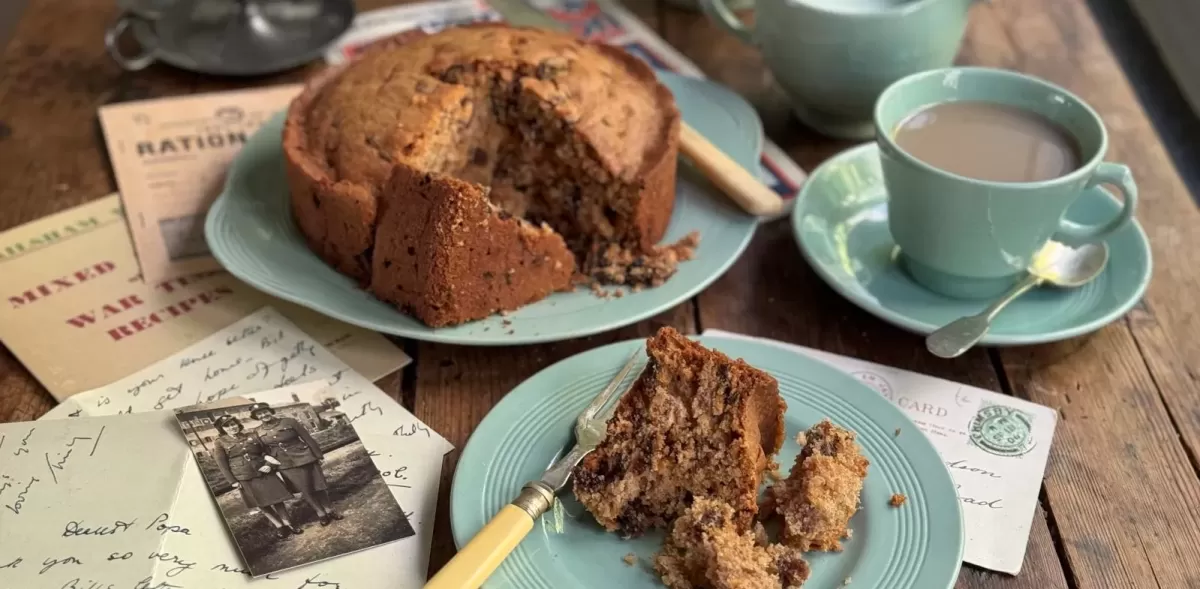 Karen's WWII Vinegar Cake
Karen's WWII Vinegar Cake
My first attempt at the astonishingly named “Vinegar Cake” was an utter triumph! There was no lingering taste of vinegar, and the cake (a farmhouse style fruit cake) was indeed light and airy with an impressive rise. How wrong I was to write it off before baking it. Those thrifty and heavily rationed housewives knew a thing or two, as did farmer’s wives, as this was a countrywide practice when the hens “were off lay”.
I notice that you blog about recipes from all decades and time periods. I’ve also dabbled in cooking from some ration recipes from WW2 myself, but keep returning to leaf through my collection of post-rationing 1950s cookbooks for inspiration, (minus all the salad-in-jelly recipes). Which decade do you like cooking from the most?
Gosh! That’s a really hard one. I love all eras of cooking (and baking), as each decade has something new or unique to offer. I’m generalising here, as in talking about the 20th century in the main. I suppose my favourite era of vintage cooking, and mainly baking, is from the 30’s and 40’s.
The 30’s gave us some quite decadent bakes, as memories of the First World War and rationing faded. And, conversely the 40’s gave us some uniquely innovative and extremely healthy dishes, due to new wartime rationing. It’s interesting that one of the best American exports, Spam (as well as their brave airman and GI’s), is still as popular today as it was back then. Plus, I’m constantly intrigued by how people created so much with very little, and yet they were still able to celebrate birthdays, Christmas and even weddings.
 SPAM was a staple in wartime and post-wartime kitchens
SPAM was a staple in wartime and post-wartime kitchens
I’m very fond of the 50’s too, but sadly it was the decade where the advent of “TV” dinners, sugary cereals, and gelatine-based fruit & vegetable salads started to infiltrate our traditional cuisine, as the post-war nation embraced “fast food” and some quite bizarre food combinations!
I know what you mean, I’ve seen some very strange recipe combinations in vintage cookbooks, particularly those pushed by the big brands of the time, like Campbells. Apparently “Tomato Soup Cake” is a thing, but I’ve never been game enough to try it! There’s an idea for a next recipe for you my dear, be brave and report back to us please? Hehe!
I’m very keen to try the Jelly and Evap mousse on your blog though, that looks nice. I know we’re not entirely sure of ‘when’ it came into existence, but I can totally see it on a children’s party table in the late 1950s. I’ve popped it down on the menu as a treat this weekend for the family.
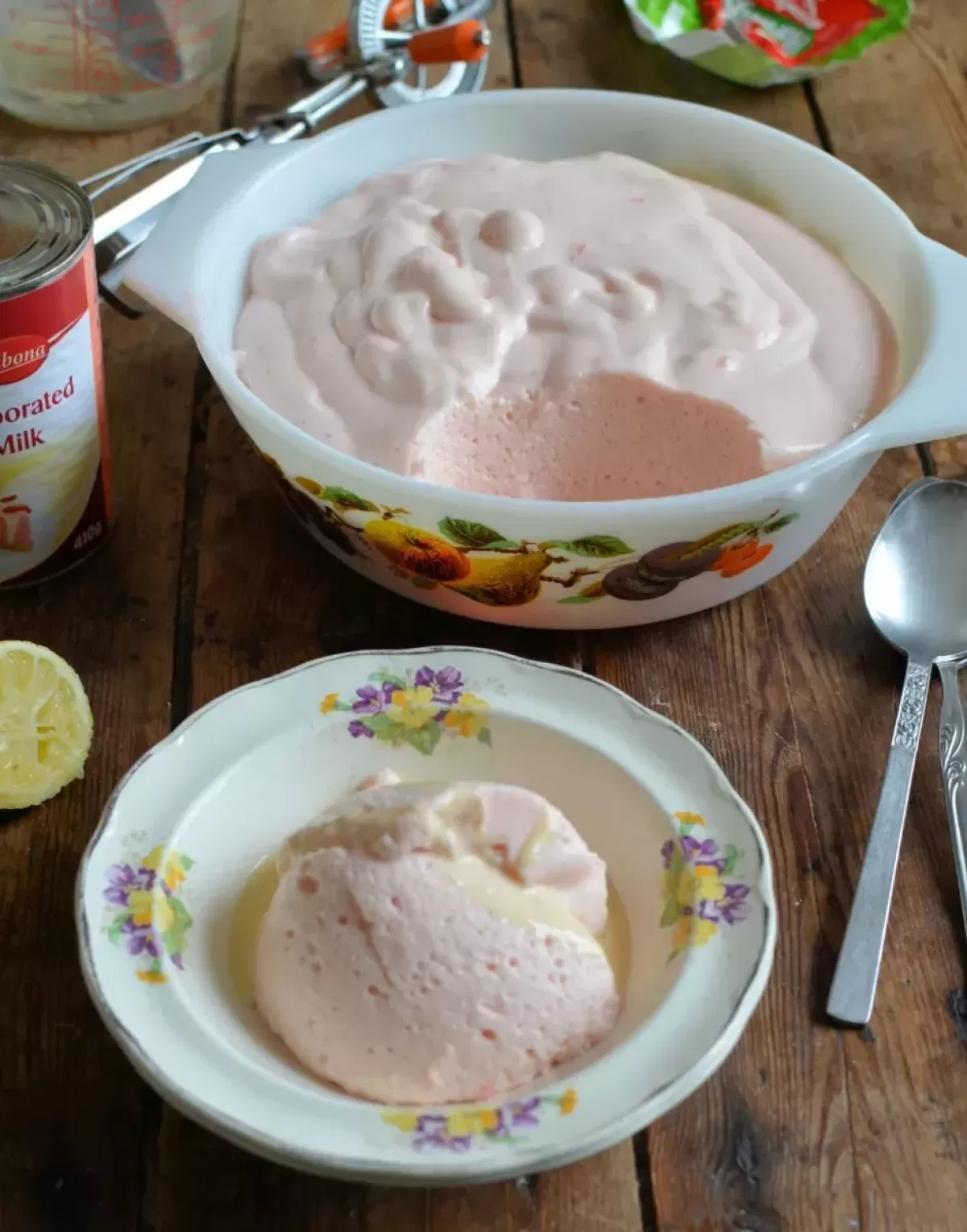 Retro "two ingredient mousse"
Retro "two ingredient mousse"
Let’s talk homemaking now, or feeling “at home”. I know that like me currently, you’ve lived abroad for some time. Can you tell me what your experience was? I’m finding it a whole new world when it comes to running a home, and grocery shopping in particular – being so unfamiliar with brands, and what’s a good deal etc. I feel like I’ve lost my mojo and as if I’m learning all over again. Any tips?
I have moved all over the world, mainly due to my father’s job, when I was a child. (He was in the Royal Navy, then GCHQ) so we lived in South Africa (where I was born), Hong Kong, Cyprus as well as in several English counties too. I suppose any feelings of being homesick were cushioned by my parents, who gave me and my sister a wonderfully safe and happy childhood, no matter where we lived.
 Karen's Mum Norma, aboard HMS Mercury
Karen's Mum Norma, aboard HMS Mercury
When I left art college I went to work in West Germany (as it was at the time), then the USA for a while. We settled in Pennsylvania’s Lancaster County for a while and I was very inspired by the Amish food culture there.
Those were what I call my “exploration days” when I had a real lust for travel and adventure. I settled down in the UK after I was married and had my daughter, before moving to Cyprus and finally SW France in search of fulfilment and happiness following a failed (and abusive) marriage.
Whilst in France I was at my happiest initially. With my second husband (and daughter) we built a thriving bed and breakfast with a cookery school. And, I started writing for a living - something I’d always wanted to do since leaving Leeds University, where I took an MA in art history and English literature as a mature student.
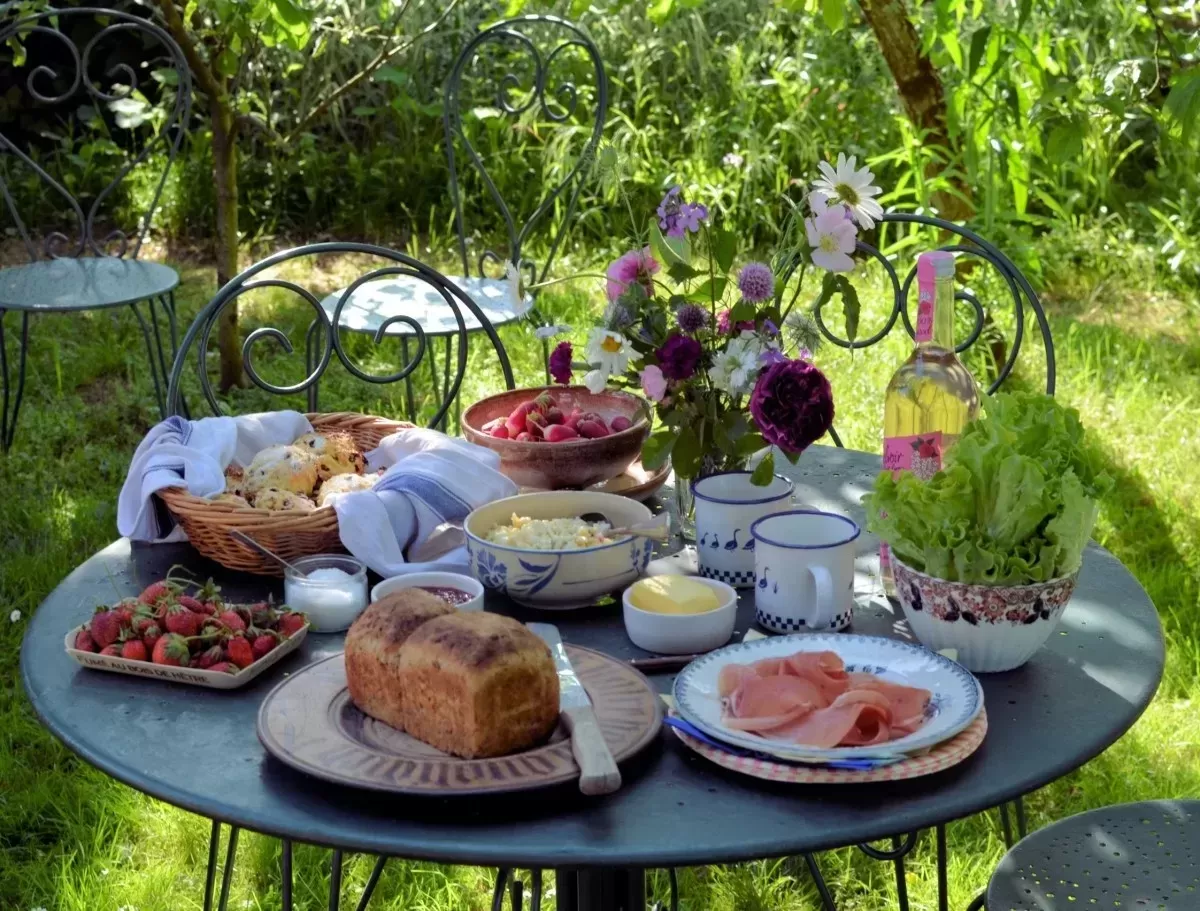 La vie en B&B
La vie en B&B
But, as you say, it wasn’t always a bed of roses, and as my parents aged, I started to feel a sense of loss and premature bereavement, plus I became extremely homesick. I’d travel back 5 or 6 times a year to visit mum and dad, but I’d cry before I had to travel back to France. Hannah (my daughter) was in university by this time, and I missed her too. It was hard.
In the end, instead of feeling lost and without any cultural foundation, I decided to build myself one via my blog and writing. I think the feelings you have right now are completely normal for somebody who has only just moved…..it does take time to adjust and you will find your niche in life again. My advice is to foster and nurture the things you love doing (moving country doesn’t stop them in my opinion) and to embrace new opportunities as much as possible, even if they feel scary at first. If any of this helps you adjust to your new life, it would make me very happy to know that in some small way I’ve contributed to your sense of belonging.
What do you miss from your time in France that England doesn’t have, or do so well?
I really don’t miss anything about France to be honest. I think we left at the right time after 18 years of living there……it wasn’t all long, lingering lunches or sun-filtered days in the local bar-bistro. It was mainly cooking for guests and doing mountains of laundry! We had a beautiful old stone house with a cellar and a walled garden, but all I remember is the hard work. I think France has the same problems as England, but with just different shaped bread.
Oooh, the “not missing it” could seem controversial! I know so many people dream of living in rural France, and there are loads of TV shows that make it seem idyllic, but I know what you mean - The grass isn’t always greener! I’d love to know, while you were away, what did England have that made you miss it so much? I really miss English supermarkets, and not paying crazy prices for mushrooms!
I missed my parents dreadfully and was almost jealous of their lifestyle in beautiful North Yorkshire, where they had lovely days out to the coast and the moors. I missed British shops and eating out - we do it so well here, and despite France’s culinary reputation, you get more for your buck in the UK, with more choice of regional and international dishes, that’s generally speaking of course, as France is a bigger country. It sounds futile and silly now, but I missed fish & chips and a good pub lunch, as well as a curry from an Indian restaurant or takeaway. (Oh same Karen! We really miss the “British Indian” curries, and a good “Pub Roast”)!
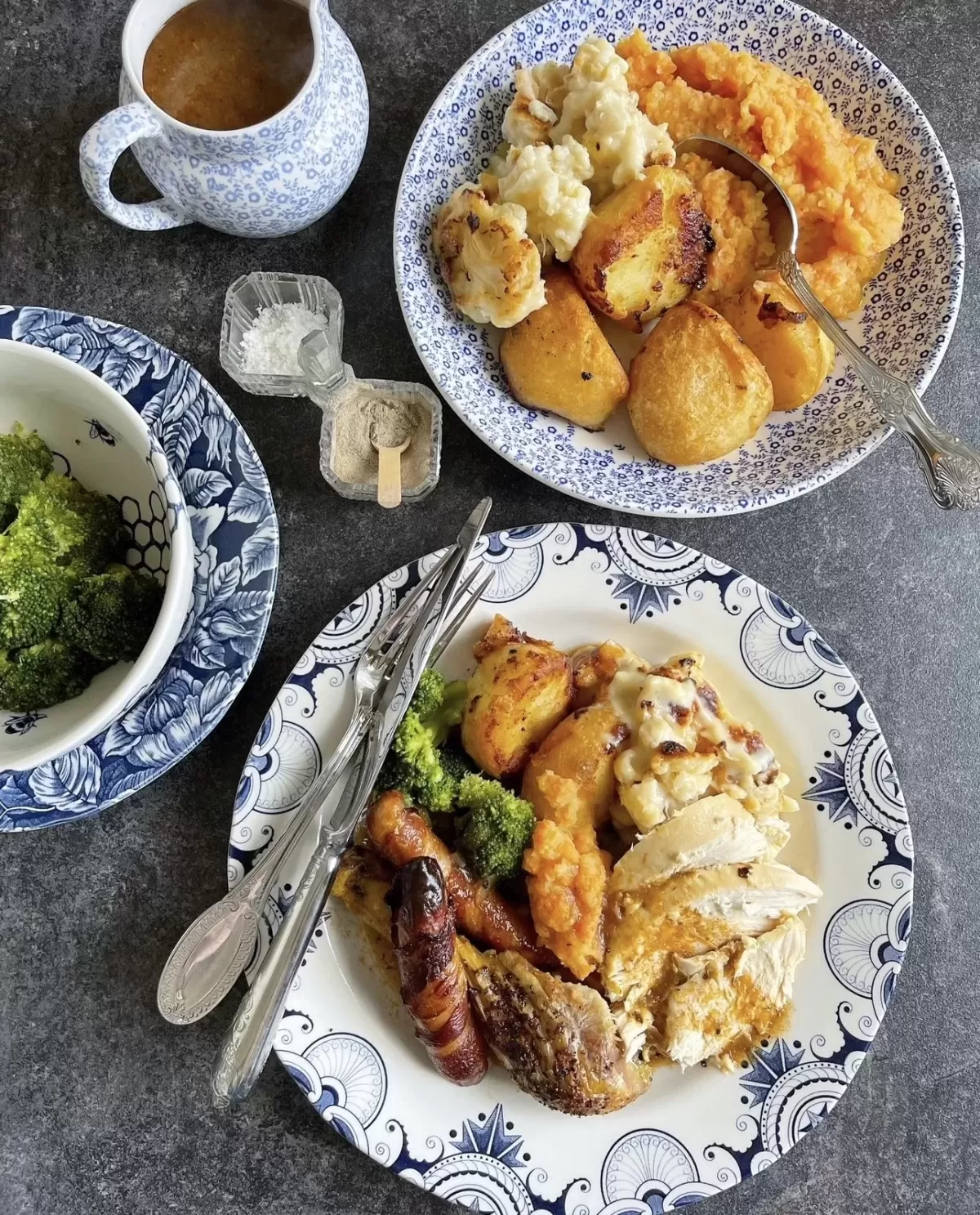 Traditional Roast Dinner
Traditional Roast Dinner
We lived in a rural village in France, bigger than mum and dad’s Yorkshire Wold’s village, and yet they had 2 pubs, a shop, and a post bus that operated 4 times a day in and out of the village, so you didn’t need your car all the time. In our French village we had nothing, although there had been a bar when we first moved there. Having said that, it was lovely where we lived in SW France - just very rural with no amenities.
British cuisine has somewhat of a negative reputation in other countries. What three course meal would you cook for a naysayer to convince them otherwise?
I was a guest chef on one of the small Viking ocean ships in 2019, and as part of that job, I was asked to create a 5 course British tasting menu for their Chef’s Table (alternative dining) restaurant. I was so surprised to be asked, as it’s a huge honour. I am the only British person and woman to be guest chef with a regular menu onboard all of their ships!
My menu still features regularly, and I’ve shared it below, along with the “blurb” about British food which goes into what inspired me to feature these dishes in particular.
“Great Britain”: Classic Tastes of an Island Nation, by Guest Chef Karen S Burns-Booth
Great Britain isn’t the first country that springs to mind when thinking of good food and wine, however, its much maligned food scene was and has become (again) a centre of excellence for top chefs, innovative seasonal cooking with provenance and flair. Ours is a nation that takes pride in its regional delicacies and ingredients; saffron was grown here and medieval stews were rich in spices and herbs, more akin to a Moroccan tagine than a homely potage. Wine was made and ales were brewed, as well as whisky in Scotland, and we have access to some of the best grass-fed beef, free-range pork, and freshly caught fish and seafood from anywhere in the world. The canon of British cuisine hinges around fresh seasonal produce that is cooked simply with care and passion. We make more cheeses than our Gallic cousins in France and our sparkling wine is winning much admiration as well as medals at international wine fairs and exhibitions. We revel in steamed “puddings”, and excel at all manner of tarts, flans and pies, as well as dainty, creamy desserts. All of this added to our love of spicy food such as curries (that were imported from India), makes for a very varied, eclectic and exciting national cuisine.
Guests started with an amuse bouche of Quail Scotch Eggs served with quick pickles, edible flowers, and a dressed baby salad. The first course, Beer Battered Fish & Chips (of course, so British), then a lovely “Granita” of Gin and Tonic with a lemon twist which served as a palate cleanser.
Then for the main course, what could be better than a Mini Yorkshire Pudding and Slow Braised Brisket, served with a luscious rich gravy, garden vegetables, and chive butter? Dessert was a “Whim Wham” which is a delicious Scottish Trifle made with raspberries, orange, and whipped cream.
 Whim Wham, a Scottish Regency Trifle
Whim Wham, a Scottish Regency Trifle
There is so much culinary history with these dishes. Did you know, that the “chips” in Fish & Chips were initially made with bread instead of potato? Due to a wheat shortage during WWII, the Minister of Food restrained rationing of this dish, but replaced the bread with potatoes because it provided inexpensive nutrition. Gin and Tonic too, quinine was used to treat and prevent malaria in British Army Officers posted to India. Roast Beef is an iconic dish, with the Yorkshire Pudding dating back to the 17th century, and a whim-wham is a Regency dish from Scotland, the word derives from “whimsy” which is just lovely.
Britain has such a diverse and rich culinary history doesn’t it! I think what amuses me the most about it all is just how far back we can trace some recipes. The history of food is incredible and so fascinating.
Now for something “modern”; let’s talk about life “online”, running a blog, and having a social media presence for a moment. What are the best (and worst) bits of being a content creator?
I love writing for my blog and for my social media platforms, mainly instagram. I did in the past have some unpleasantness with other bloggers, and I was quite damaged by their gossip and nastiness. Friends and family told me it was professional jealousy, and I suppose looking back, I’d agree with them. But at the time I was so hurt and upset, that I nearly stopped writing my blog.
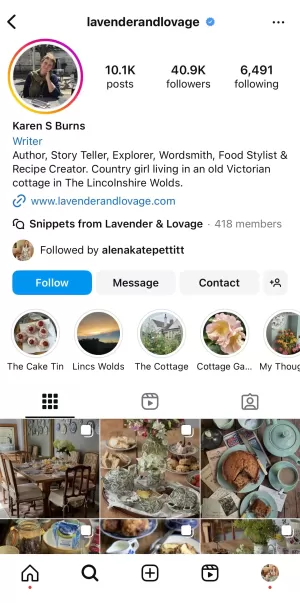 My social media presence is quite muted really - I have an average, not a huge following of 40k+ on instagram - but I’m proud to say that I built it myself, by engaging with people, commenting, and not buying followers either, which seems to be common practice now with “influencers”.
My social media presence is quite muted really - I have an average, not a huge following of 40k+ on instagram - but I’m proud to say that I built it myself, by engaging with people, commenting, and not buying followers either, which seems to be common practice now with “influencers”.
I say my presence is muted, insofar as I don’t really post reels of myself (or my family), in fact I’m rarely in front of the camera!
I know it works for some people, but I don’t class myself as an influencer, and I enjoy styling and curating my photos (all stills) and sharing snippets of my life without me being in shot. I could have gained hundreds, if not thousands more followers (I hate that description!) by sharing reels, but it really doesn’t fit in with my lifestyle, and I’m more a lover of still life, that I can pause and enjoy, with no annoying music!
The best of social media has been meeting some truly lovely and fascinating people, yourself included!
That’s so nice of you to say! I think this is the best part if it, meeting people with interesting stories is a real pleasure in connecting with those you’d otherwise never cross paths with.
Aside from your love of vintage recipes, your food photography is so wonderfully nostalgic and you can tell you take great care in the presentation and thoughtfulness of what comes out of your kitchen. What tips would you give someone who is looking to romanticise her daily menu a little more, or start some traditions of her own?
I think we’re all in too much of a hurry now - myself included sometimes! I remember always sitting down at a table for breakfast, lunch and tea when I was growing up. Mum would lay the table with a table cloth (seersucker gingham for weekdays and cream damask for the weekends), cutlery, a cruet set and condiments decanted into glass bottles and pots. We always had cups and saucers too…..although mugs crept in later on in my parent’s lives - but still teacups and saucers for the weekends and special occasions. I still do this now, especially as I’m one of Burleigh Pottery’s ambassadors, so I have some exquisite cups and saucers (plus other gorgeous china) they’ve sent me.
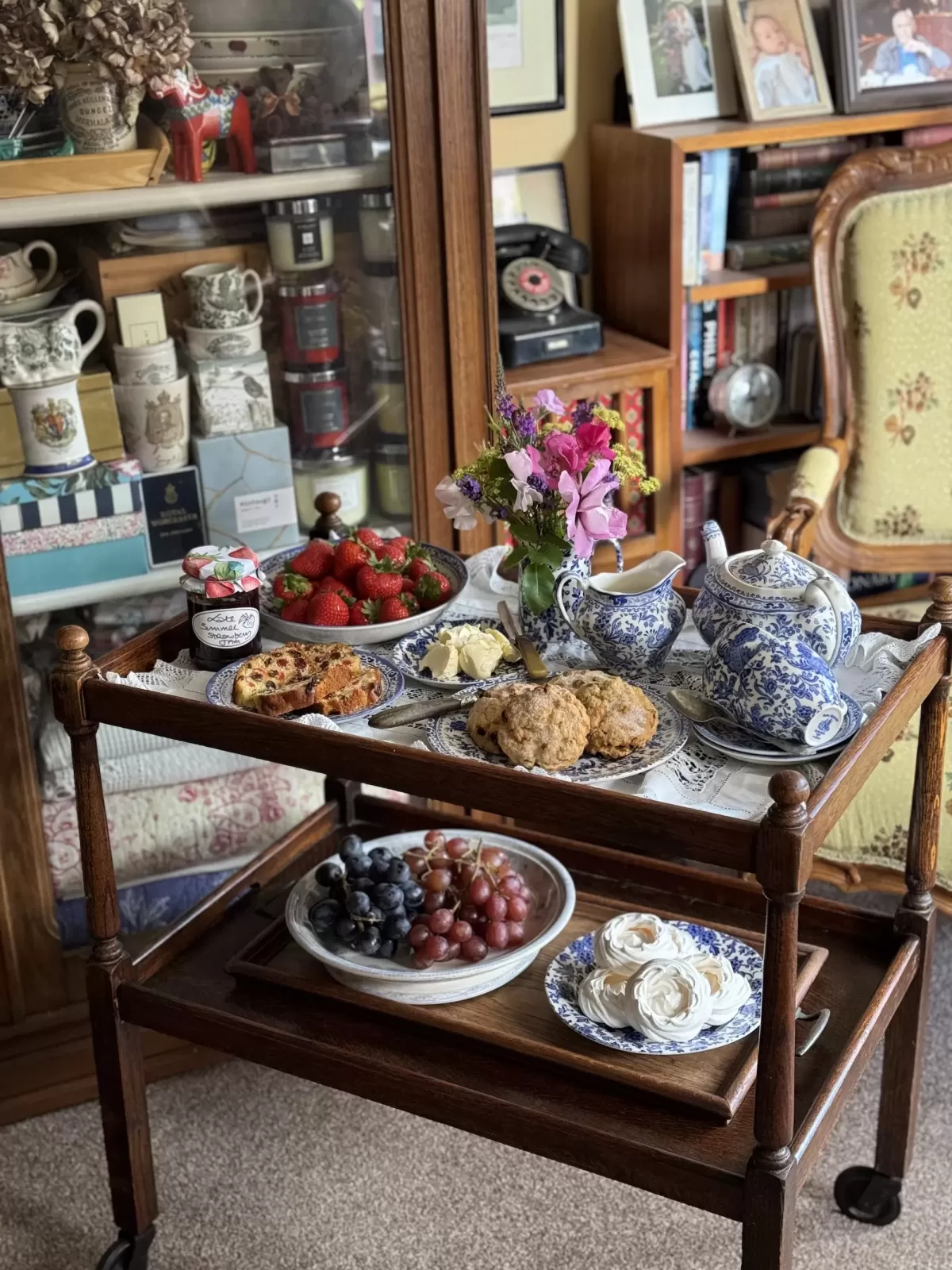 A peek inside Karen's beautiful home
A peek inside Karen's beautiful home
Flowers are always on my table, whether they be hot house exotics, cut flowers from our own cottage garden, or wild flowers from the surrounding meadows and hedgerows.
Salt and pepper is often just plonked on the table nowadays, in its carton or bottle - I love to decant salt & pepper into my numerous cruet sets - they add a touch of elegance to a romantic table setting. Condiments such as vinegar, mustard and mint sauce look so much better when decanted into a special glass vinegar bottle and bespoke pots for sauces and mustard.
Whatever you cook, whatever the menu, I’m sure these tips will only enhance your eating experience.
You have so many wonderful “props” that make your images an utter joy to look at, and I can tell that we both get a bit giddy for vintage kitchenalia. Where are your favourite places to shop for bits and pieces?
I scour charity (op) shops and car boot sales for bits and bobs, (“just for food styling”, I say to my long suffering husband as I bring another bag of culinary loot in!) Haha, oh Karen, I’ve said that too, guilty! Haha, I’m glad I’m not the only one! I also source items online if I have something specific I’m looking for, and there’s a few favourite vintage shops I buy from on instagram too. Antique shops are usually too rich for me, but I’ll always pop in to see if there’s a bargain to be had or just for inspiration.
 Karen's French Linen Press houses some of her collection
Karen's French Linen Press houses some of her collection
Lots of my kitchenalia is inherited, mainly baking trays from my late mum, a rolling pin that was my grandmother’s, my mum’s Tala measuring cone, nanny’s vinegar bottle, the other nanny’s Indian Tree china and so much more.
What one kitchen item, pretty or practical, would you save if disaster struck, and why?
Absolutely my late mother’s Tala Measuring Cone - I measure all my loose ingredients in it, and I feel a profound sense of belonging and being closer to her spirituality when I use it. It comes with precious memories of her, and the countless times she sifted flour or sugar into it, to make scones, pastry or cakes. It’s a bit battered now, and the base is loose, but I love it so much, and I’d never part with it.
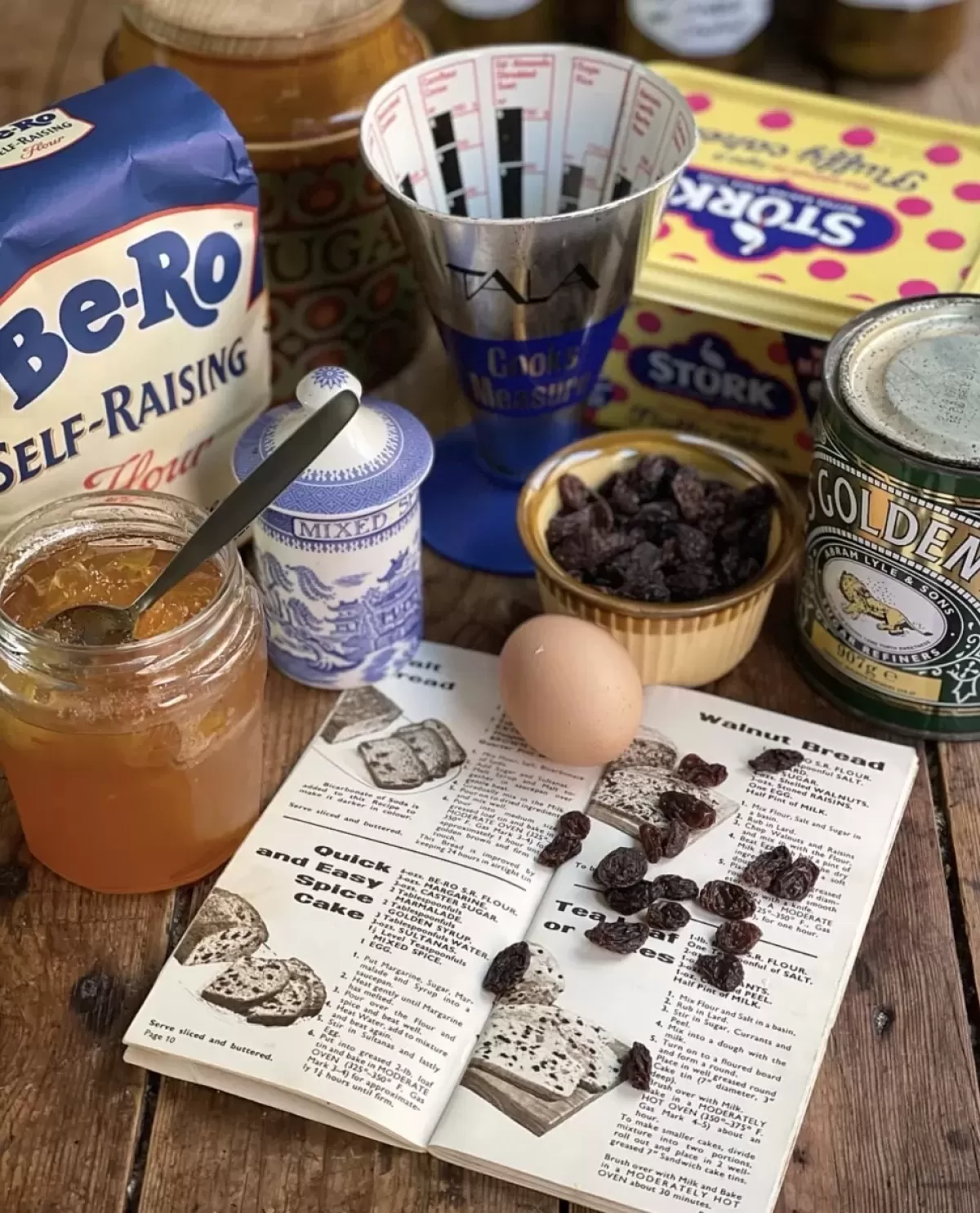 It's the little things that hold treasured memories
It's the little things that hold treasured memories
Your book is now in its sixth reprint, and will be available again soon. If a reader were to add it to her bookshelf, which recipe would you suggest she begin with, and why?
That’s a hard one to answer, as all the recipes mean so much to me, but as you’ve asked me to choose, I think I’ll go for “Mum’s Cheese and Potato Pie” - a family favourite, with dad, me and my sister; and now, with my family and my daughter’s family too.
 Cheese & Potato Pie
Cheese & Potato Pie
Why? Because it’s a comforting family recipe that is easy to make and is great all year around. Plus, you can also use this recipe for the potato topping in Shepherd’s Pie, Cottage Pie or Fish Pie. It was the last dish mum made for me when I visited her before she passed away; we ate it in companionable silence, in her cottage kitchen, with the wind howling outside, the clock ticking on the wall and with the love of a mother and daughter warm all around us…..happy, happy memories.
A fun conversation starter I like to use at dinner parties is “what is your perfect three course meal”? Mine would be a starter of eggs benedict, a roast beef dinner with all the trimmings, including cauliflower cheese, yorkshire puddings and lashings of gravy, followed by apple crumble and custard. However the crumble needs to be piping hot, and the custard cold (from a tin). Weird, I know, and I might need an outfit with an elasticated waist, haha! It’s also slightly strange to eat breakfast as a starter, but that’s the fun of it! What are your choices?
Wow Alena! Another hard one! Let’s see……my perfect three course meal would probably be:
Homemade chicken & ham terrine with toasted homemade bread (sourdough maybe) with good salted butter (or even dripping), homemade pickles and chutneys.
Followed by Roast Chicken with all the trimmings such as fragrant sage, onion and sausage meat stuffing, roast potatoes, steamed savoy cabbage, minted carrots & garden peas, cheesy cauliflower cheese and thick, wine-infused chicken gravy. I might add a small hill of fluffy mashed potatoes to that plate too, if I was so inclined!
Pudding would be unashamedly simple, it would be homemade Bramley apple pie with a buttery shortcrust pastry, served warm with thick (cold) pouring cream. How’s about that then?! Avec candles of course! I love your menu choices by the way, and I’ve always liked traditional breakfast dishes served throughout the day myself.
That all sounds delicious! Might need to book myself a plane ticket to visit you soon. Your kitchen table sounds the ideal place for home comforts. It’s been so nice chatting with you Karen.
Thank you so much for inviting me to tell you more about my passion for vintage cooking Alena, it’s been a lovely couple of hours where we’ve both explored our mutual love (obsession!!) of how it should all be done properly! My teapot is ready for a refill, and I hope we can continue to have some more online chats in the future, albeit with the huge distance between us. However, I think it’s never a problem with kindred spirits, lets get the kettle on in another week or two.
![]()

A big thank you to Karen for joining us today. If you’d like to keep up with her blog, you can do so here.
You’ll also find details on how to purchase her cookbook, and make sure to follow along on Instagram or her Facebook Page for lots of inspiration.
Happy cooking!

Would you like more content like this?
Please feel free to contact me if there is someone you’d like me to interview next whose values align and you think our readership would enjoy hearing from! Our mission at The Darling Academy is to encourage women to fully embrace and flourish in their decision to stay home in this modern world. We support those living a traditional family-centred life in a world that tells us it’s ‘not enough’ to keep house.
I hope you have enjoyed this post. If it has blessed you in some way, would you kindly consider supporting the blog for the cost of a cup of tea? As always, I am incredibly grateful to the Patrons of The Darling Academy for their continued encouragement and kindness. Support helps with running costs of the website and for tea, which fuels the writing of our articles.
All content and images in this article are copyright of The Darling Academy and are not to be shared or reproduced without our express permission. All images belong to Lavender & Lovage - used with permission.

